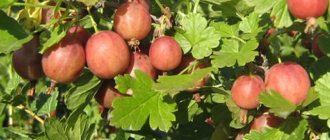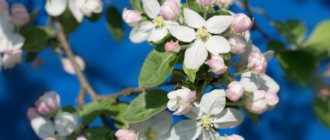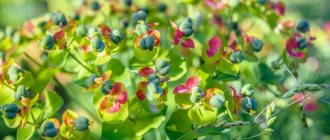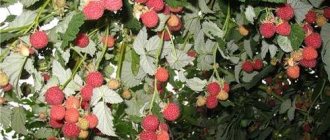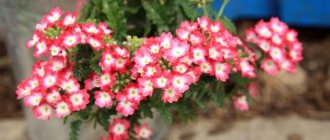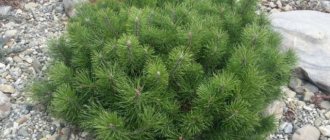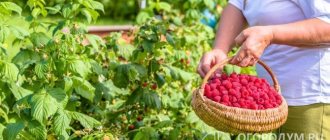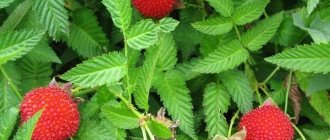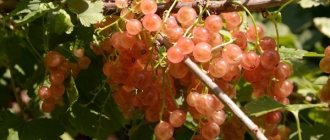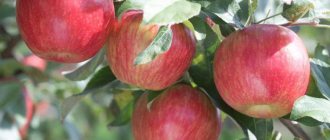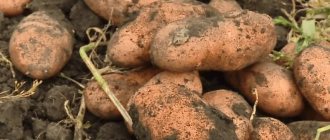Gardeners are increasingly focusing their attention on dwarf and bush forms of apple trees, which are undoubtedly very convenient for cultivation, especially when it comes to regions with difficult climatic conditions and harsh winters. Seedlings of such an interesting type of apple tree as Krokha are in great demand. And this is not surprising: stunning appearance and tasty fruits, as well as quite good yield - not a single avid gardener will pass by this!
If you are still thinking about the question “Is it worth buying the Krokha apple tree variety?”, then our article is just for you!
additional characteristics
Advantages and disadvantages
If we group the positive characteristics of the Krokha variety, then among them it is worth highlighting:
- Aesthetic appeal of the bush;
- Decent taste of the crop;
- Universal purpose of fruits;
- Resistance to scab pathogens.
The main disadvantage of the variety: ambiguous resistance to frost.
Morphology
The bush apple tree Krokha grows into a beautiful spreading rounded bush 60–70 cm high , the lower branches are parallel to the soil and, when in contact with it, can take root, forming shoots. The branches and shoots are covered with bluish-green leaves, medium-sized, glossy, leathery.
Apple tree Tiny.
The fruits are medium in size, can reach 100 grams in weight , have a round shape, with noticeable ribs in the center.
The fruit is covered with a thin green peel with a white tint, the pulp is coarse-grained, pleasant consistency, snow-white, with a delicate aroma and delicate sweet and sour taste.
Frequency of fruiting
The Krokha apple tree variety produces regular annual harvests ; no pronounced periodicity in fruiting has been identified.
Yield and tasting rating
The Krokha variety is characterized by high yield ; on average, it can be 2–3 buckets per bush. The fruits received a good rating in terms of taste.
The Krokha apple tree brings a harvest of up to three buckets per bush.
Winter hardiness and disease resistance
Nurseries selling seedlings of this apple tree advertise amazing winter hardiness, but, as practice shows, in reality everything is much more complicated.
In its form, Krokha is ideal for the northern regions: the short stature and arrangement of the branches is such that, being under snow cover all winter, it tolerates the winter well. This applies to the aboveground part of the plant.
But the root system of dwarf varieties is quite fragile , and this is precisely the Achilles heel of the variety: in order for it to show the promised winter hardiness, proper agricultural technology is needed.
Tiny's root system suffers in cold weather.
Important! Adhering to the right approach to agricultural technology, it is quite possible to grow a Krokha bush apple tree.
It requires a special approach, from planting to caring for the root zone. As for resistance to diseases, the apple tree of this variety perfectly resists scab pathogens.
In which regions is it better to grow bush apple trees of the Krokha variety, descriptions and reviews from gardeners
Many gardeners are interested in growing compact apple varieties. At the same time, the bush variety of apple trees Krokha, which is distinguished by its yield and taste qualities of the fruit, is popular.
Description of the Krokha apple tree
It is necessary to read the description of the plant in advance to find out its features. A distinctive feature of the variety is the height of the tree, which grows up to 50-55 cm. The plant is covered with small branches that are capable of taking root in places of contact with the soil. The fruits of this apple tree are of medium size and grow to 80-90 grams. They have a pleasant taste and juiciness.
Gardeners advise growing Krokha in regions with warm climates, as the plant does not tolerate frost. This is due to a weakened root system, which ceases to function due to frost.
Pros and cons of the variety
Every gardener who is going to plant Kroha on his plot should know its positive and negative sides.
Among the main benefits of apples are the following:
- attractiveness and compactness of the bush, which allows it to be grown in small gardens;
- pleasant taste and juiciness of ripe apples;
- the versatility of the fruit, thanks to which they are used for cooking and canning;
- protection against scab.
There are far fewer disadvantages than advantages. The main disadvantage of the apple tree is its poor tolerance to low temperatures.
Main characteristics
To get a good harvest, you need to familiarize yourself with the characteristics of the crumbs.
Dimensions
The size of the trees is considered a distinctive feature of the variety, since even adult plants do not grow to more than 55 cm. Therefore, this apple tree is suitable only for lovers of compact dwarf trees.
Productivity
Gardeners classify Krokha as a high-yielding variety of apples. 3-4 buckets of ripe fruits are collected from one tree. To increase productivity, it is recommended to grow the plant in greenhouse conditions.
Frequency of fruiting
Planted apple trees bear fruit two years after planting on the site. Every gardener who has planted such apples harvests the ripe harvest once a year, in the first half of August.
Winter hardiness
Manufacturers who sell Krokha claim that it tolerates frost. However, reviews from gardeners indicate the opposite, as they complain about poor resistance to frost.
It is not recommended to grow such apples in open ground in the northern regions.
Disease resistance
The trees are reliably protected from common diseases that affect apple trees. However, experienced gardeners still recommend regular preventive maintenance to further protect plants from pests and pathologies.
Fruit evaluation
The baby is not distinguished by large fruits, since their weight reaches 80-100 grams. They are covered with a dense yellowish skin, under which there is aromatic and juicy white pulp.
Spreading
The variety should be grown by residents of the southern regions, where the temperature is suitable for growing apple trees. However, such trees are also planted in other regions where the air temperature is often above zero.
What are the subspecies?
There are three types of crumbs: creeping, bush and dwarf plants. The latter are suitable for beginners, as they are easy to care for and do not require shaping. Bush plants will have to be trimmed regularly as they grow quickly. Creeping apples will have to be tied to supports so that the fruits do not rot on the ground.
Reviews from gardeners
Antonina: “I’ve been growing Krokha in the garden for more than three years. Of course, at first there were difficulties with young trees, which froze in winter. However, by spring the situation improves and the plant begins to grow normally.”
Andrey: “At first I planted an apple tree on the street and immediately regretted it. The plant did not even survive the first winter and died. We had to install a greenhouse on the site so that the trees would grow normally.”
Reviews
Natalya, Pskov. “I saw enough photos and descriptions of the variety on the Internet, read descriptions from nurseries and bought a seedling of this Tiny. After the first winter the plant died. There was no winter hardiness lying nearby. Maybe I did something wrong, but the fact is that the seedling disappeared after the winter, which it supposedly should have survived well!”
Sergey, Bryansk. “Yes, if you garden properly, you can grow anything. My baby has been growing for 7 years now. There was a case of freezing, but it took off in the spring and everything is fine. You just need to read the literature, more about dwarfs and ways to protect trees from the winds.”
Olga, Saransk. “Oh, I really wanted to plant Baby at my dacha, but now I’m afraid. My neighbor treated me to some delicious apples! And what a wonderful bush it grows, it’s simply a miracle! Small, neat, when it blooms it simply enchants with both its appearance and its smell! Maybe I’ll try to tame this cute little one this season!”
Pruning and crown formation
The main task in pruning the crown is to maintain a balance between old branches and young shoots. This greatly influences the increase in crop yield. It is advisable to choose a time for pruning when the active flow of sap has not yet begun, i.e. in early spring.
The first pruning is carried out in the year of planting, and it is necessary to shorten the central trunk for the subsequent uniform growth of the plant and the absence of extra branches that will only obscure future fruits.
Features of planting and care
Dates and methods of planting
In order to set the correct pace of healthy development of the Krokha apple tree seedling, it is necessary to properly plant the plant in the garden. Before you do this, you need to choose the right area:
- It should be on the south side of the garden;
- And in a sunny place protected from harsh winds.
Next, prepare a planting hole , the depth of which should be at least 60 cm, width - at least 70 cm, a layer of drainage is placed on the bottom (for this purpose you can use broken bricks, stones, fragments of clay pots) with a width of 5 cm, then in the center the holes are placed with a peg that performs a supporting function.
A seedling is placed next to the peg, the roots are straightened in all directions, carefully and very carefully. Then the hole is filled with a mixture of fertile soil and organic matter, compacted layer by layer.
Watch the video with tips on preparing the planting hole:
Important! It is useful to use a mixture of seed husks, humus and soil in equal parts to fill the planting hole. Husks (which can be replaced with vermiculite) loosen the mixture, and humus provides the necessary nutrition to the plant.
As for the timing, it is best to plant an apple tree of this variety in the spring before the buds open.
Watch a video about spring planting an apple tree:
Agricultural technology
Varieties of bush apple trees require a slightly different approach than classic varieties. This applies, firstly, to the root zone. It must be loosened the next day after watering and weeds must be removed in a timely manner.
Loosening the trunk circle of an apple tree.
It is also recommended to sow herbs (green manure) to improve the nutrition of the apple tree and protect it from temperature changes in the autumn. Most often, bluegrass or field fescue are used for this purpose.
Types of green manure.
As for fertilizing, it is necessary to apply mineral fertilizers from spring to late autumn to form primary roots, in which growth hormone is produced, which affects the development of the plant as a whole.
As a top dressing, azofoska is used, which contains both nitrogen, phosphorus and potassium. In autumn, in order to prepare the plant for a difficult winter, it is necessary to apply phosphorus-potassium fertilizers.
Watch a video about how and with what to fertilize apple trees:
Important! Spraying a solution of Zircon or Epin on the green mass will help to quickly remove a tree from winter stress.
Watering is carried out as the top layer of soil dries; in hot weather, the tree trunk circle can be mulched to maintain soil moisture.
Watering is carried out as it dries.
Pruning and crown formation
The main task of pruning bushy forms of apple trees is to form the crown in such a way as to balance the number of shoots: old and formed in the current season.
This allows you to stimulate the formation and formation of the crop.
The ideal time for pruning is early spring before active sap flow begins.
The first pruning is carried out immediately after planting - the central conductor is shortened; in subsequent years, pruning should form a bush that is even on all sides, so that the formed fruits are in the sun and are not shaded by excessive greenery.
Watch a video tutorial on shaping and pruning an apple tree:
Pollinator varieties
The crumb is a self-fertile apple tree , so for normal active regular fruiting there is no need to plant certain types of apple trees.
Diseases and pests
The Krokha apple tree resists scab disease well, but damage is possible during wet periods and if agricultural practices are violated. Therefore, twice a season it is recommended to spray the crown and tree trunks with drugs against pathogenic infections. In case of damage, treat with targeted chemicals, according to the instructions for the preparations. Any disease and pest damage is easier to prevent than to treat.
Find out how to get rid of bark beetle on an apple tree.
To do this, preventive measures should be used:
- regular inspection of the apple tree, removal of problematic branches and leaves, stripping of the bark;
- whitewashing with lime solutions and early spring spraying with Bordeaux mixtures, biological products and folk remedies;
- removal of weeds, young growth and plant debris from the territory;
- sowing plants in the nearby area that can repel pests (chives, mullein, clover, mint, garlic, marigolds, fennel, etc.);
- installation of fishing belts and traps.
Hunting belt on an apple tree. In the budding phase, treat against flower beetle pests with insecticides (Fufafon, BI-58, Ditox, Pirimix, Zolon, etc.). Biostimulants of growth activity (Zircon, Tsitovit, Epin) and timely feeding with nutrients can increase the immunity of the apple tree, and thereby increase resistance to diseases and pests.
Features of ripening and fruiting
Beginning of fruiting
The Krokha apple tree begins to bear fruit in the third year after planting , then it grows every year and by the fifth year the tree can be considered mature and fully fruit-bearing.
The baby begins to bear fruit in the 3rd year.
Deadlines
Blooms
The baby is covered with fragrant small flowers in mid-May , decorating the garden with its neat flowering bush.
Blooming apple tree Krokha.
Maturation
The fruits of Krokha begin to ripen in mid-August, and by the end of the month the entire crop is ready for harvest . The apple tree bears fruit abundantly and amicably, thanks to its low growth, it is very convenient to collect them.
Fruit storage
The apple fruits of this variety are universal in purpose; they are used both fresh and for preservation.
But they can be stored for a very short time:
- Outside the refrigerator - within two weeks;
- In low temperature conditions – maximum 30 days.
Pros and cons of the variety
Every gardener who is going to plant Kroha on his plot should know its positive and negative sides.
Among the main benefits of apples are the following:
- attractiveness and compactness of the bush, which allows it to be grown in small gardens;
- pleasant taste and juiciness of ripe apples;
- the versatility of the fruit, thanks to which they are used for cooking and canning;
- protection against scab.
There are far fewer disadvantages than advantages. The main disadvantage of the apple tree is its poor tolerance to low temperatures.
Apple tree Tiny
Dwarf
The variety itself has a fairly compact tree structure, so growing dwarf forms does not make much sense.
Bush
To achieve the correct formation of the bush, you need to carry out regular pruning on time and in the volumes specified in this article.
creeping
The crumb can be cultivated as a creeping variety; for this, the following methods of forming branches must be used: the lower branches, located close to the soil surface, are fixed with special hooks to it, thus the bush becomes more “flat” and wider, and better tolerates wintering in harsh winters with cold gusty winds.
Methods for forming a creeping apple tree.
Advantages and disadvantages
When choosing a variety such as Krokha for the garden, it is worth getting acquainted with both the advantages of this plant and its disadvantages:
- advantages: a fairly compact bush that allows you to grow apples in a very small garden plot, excellent taste characteristics of the fruit, as well as their versatility in use, resistance to scab;
- disadvantages: fairly average frost tolerance, despite its size. The high vulnerability of the root system, which is located close to the surface, significantly reduces the survival rate of the variety in harsh winters. But provided that agricultural technology is used correctly, this drawback is eliminated. In addition, one of the disadvantages is that it is demanding in care: the bush must be pruned annually, otherwise the plant’s productivity will sharply decrease, additional care is required for the root system, in the form of periodic sprinkling.
Growing in regions
Middle lane
In the central zone, cultivation of the Krokha apple tree is quite possible ; the variety is positioned as winter-hardy, so there should not be any special hassle in caring for it.
Siberia and the Urals
Dwarf bush forms are ideal for growing in cold regions. Following the correct algorithm of agricultural technology, timely and complete care will be the key to the successful cultivation of this crop.
The Krokha apple tree is an ideal option for Siberia and the Urals.
Forum statistics
207035 Messages in 1634 Topics from 5593 Users. Latest user: Amaya Latest post: “Figs. Varieties and grown..." ( Today at 07:43:43) Latest messages on the forum.
Now on the forum
35 Guests, 9 Users
Users in the last 15 minutes: 64nikolay64, lomakin1969, therapist, Capricorn, Alexander Vl., Elvira2017, Marshal, Andrey76, Slavka [Blocked] [Section Moderator] [Forum Moderator]
Maximum online today: 77 . All-time maximum online: 2758 (28 July 2021, 17:22:51)
Users who visited the forum in the last 24 hours
Total: 296
(Visible: 295, Hidden: 1) 1963, 64nikolay64, lomakin1969, therapist, Capricorn, Alexander Vl., Elvira2017, Marshal, Andrey76, Slavka, Mikhail77, ElenkaF, Tatyana B, Alex65, Cherkessk, Eugene, zsb, Leonidych, vladimirM, yotmast, mers, Serg1707, SNovichek, hanter64, znakomij, Alexander K, Vardan, Sergey Fer, Anatoly Sivkov, Alexey V, Ilya 77, Andrey Gladilin, Tatyana A., Belgorodets, in Astrakhan, Oksana Kopp, sem_en, Vladimir 153, skier , Igor Viktorovich, slavalimon, Primorets, OlgaOs, SANYCH, 31rus, mystic69, DorontsovPeter, Andrey Tsvetkov, Buba, igor222, Elena Z, vlad51, Kenig, Nikolay Rex, Sergey 1965, Vladimir Buturlakin, DSW, psv1960, Dmitry 77, Vasily V ., Vyacheslav03, Natalia Nikolaevna, Sergey Tashchiyan, Nikolay S., Igor Sergeevich, alexsandr, kvg, Pioneer, Ekaterina Polyanina, nicson7, Elena Aleshchenko, Alexander-ask-34, Verona, Igor F., Taker, Tikhiy, Henry, Yuri72 , L.A.P., Gaivoronsky Yuri, Sergeevich, Sergey Chistokletov, Svetlana Streletskaya, Galinka, Alexey Deminov, Naumov Igor, Vyacheslav136, Gloomy, Katrin, AndSanych, Mikhno Alexander, Ded31, Filippov Oleg, Vladimir ++, Svetla777, Mikhail Alekseevich, Lydia58, ALEXANDER BRYANSKY, Vladimir-kanevskaya, DIL, Amber7394, Marina Protasova, TITOVA LYUBOV, Linx, alexander66, Natalya M, Mikhail Fesenko, Amaya, Alexander71, Boris 1952, tsv, Maximilian, 25nata35, nadia, GALINA ANOKHINA, Igor_K , Alexander Kolesnikov, Ivan Levin, Pitko, weather forecaster, eSAa, cecet71, atseton, Alexander Smirnov, Vladimir Kostochkin, Vladimir Berdnikov, Gocha, pioneer-2, LeXa_KoT, Sergey 61, Sergey Yuryev, Erem, alexss, Evgeniy52, Skif, Vladimir Kovba , dayton, Yuri Semenov, N.A. Sokolov, Pavlentiy, Sa-shura, Volgogradka, Dmitry Anatolyevich, Grandfather Igor, Andrey Lis, Bublichenko Alexander M, Marina Krymskaya, stenlly2010, irahelm, Vyacheslav Vladimirovich, Vladimir Shilov, Aprel, Dmitry Badaev , gheo55, Yura, y_fed, rambo, Yagodka, Valentina Ivanovna, Kryn, oleg9f, DED2, Svetlana Korotina, Oleg Ivanovich Zavezen, Eduard., santra, L2k2m7n, Alexander48, Viknik, Andrey 31, m2d, Valery Rastorguev, Soshnin Yura, Gardener — amateur, Galina, Vasily1111, gardener, marlin64, Salex, sergei, Sergey Ko, Ramiz, victor_, kosmos, potap05, Yuri 36, VitalySD, Inna161, Vova Kapran, Vladimir Shcherbinin, Valerie, niy1, cfibr, Andrey68, kulol3, thanatos , Serzh1978, Realist, Artur53, max2008-01, LOZA, AlexanderD, Grandfather Young, Natasha, Zayac, ketch, Rita, alx-74, Iv Iv, Alexander150, Igor K, Vasily Viktorovich, VeraNiK, kdm57, Veniaminovich, Boris Sokolyansky, 77volt, , vikbublik, neposny, Evgen, Victoria Aleksandrovna, Serezha 64, Wintel, Airbone, teri, Sergey Lomonosov, Khramov, serginio, Leonty Yarygin, Irina O., Ser, Nadezhda Grig, Lyubov S., netolya, Saisan, Alexey Agryzkov , Vadi, Zinaida, Vadim, Alexander Taganrog, Sergey Sukhonos, Snezhinets, evgen_26, nau_63, Masha_sadovod, Gennady163, krasnovlad1, Alexander Zinoviev, Vasily 53, Roman Fedorovich, TIS, Alexey Sergeevich, arnyusha, Zheka, Nurtas, kradievska, nick041, Liza , Valentina Medvedeva, Sergey43, Andrey S., Nikolay Lipunov, Mst, Vertuoz2, Vladimir VS, NatalyaMed, freesia, Kinna, Mikhail Michurinsk, alekcsan1, VALERY TAMB, Sasha57, MikhAf, Y_Azer, Andrey Beribesov, hunter1955, nut lover, Keys, Ivan Shmelev, Pestik, anton_slash, Nadymchanka, Sergey 31, Volgar, Pavel 64, Tatyana Volzh, Elektronik_t, Alexander 61, spotlight, Alexander Guy, Cheprak, Pirko Alexander, vladimirvrn, Antrikan
About proper landing
Despite the low-growing variety, the apple tree requires a deep and wide planting hole. In order for the roots to feel protected in the cold, you will have to dig a hole under them at least half a meter deep and about the same in width.
To avoid stagnation of moisture, the bottom must be equipped with drainage. To organize it, you can take broken brick and line it with a 5-centimeter layer.
Sprinkle the seedling not only with soil, but also with a mixture of seed husks and humus. The proportions are taken equal. Humus and husks provide a flow of oxygen to the roots and serve as a kind of complementary food. The top cover of the apple tree trunk circle must be sown with bluegrass or fescue. Due to the production of biological nitrogen, grass improves the nutrition of the tree.
After the planting procedure, a good gardener will not stop and let everything take its course. The apple tree needs follow-up care.
Variety Bratchud
| Entry into fruiting | Tree height (m) | Fruit weight (g) | Harvest | Shelf life (days) | |
| For 3-4 years | 1,5-2 | 140-160 | End of September | 120-140 | |
The winter variety Bratchud, which was included in the State Register of Breeding Achievements in 2002, attracts gardeners with its extraordinary endurance, frost resistance and excellent yield. The full name of the variety is Brat Chudny, it is suitable for growing in all climatic zones. The tree is a natural “dwarf” with a flat-round crown with a diameter of up to 3 m.
The size of the fruits usually does not exceed average sizes. Their distinguishing feature is the presence of a small seam in the form of a strip. The skin is dry, with a glossy sheen. The main color of the fruit is greenish-yellow, later a purple blush appears.
The pulp of ripe apples is white, coarse-grained. It cannot be called juicy, but the taste remains pleasant. The variety is high-yielding, transportable, with a long shelf life.
Caring for dwarf varieties
The variety “Krokha” requires control over the formation of the crown. Timely and competent pruning allows you to organize any form of branches: dwarf, bush or even creeping. To set the desired growth, the first pruning is done immediately after planting. Each pruning to restore strength to the apple tree after the “operation” should be accompanied by restorative fertilizing.
In general, this variety requires three feedings per year. It is made from a solution of ammonium nitrate: 40 g of the drug is diluted in 10 liters of water.
The nutrient solution is applied under the tree. As the dwarf apple tree grows and matures, this dosage is increased. Each year, 30 g of the drug is added to the standard ratio.
It goes without saying that care should be accompanied by circular hilling and protection from insects and rodent pests. The measures taken in this regard are common to all types of apple trees (spraying with pesticides, whitewashing the root part of the trunk).
What is the difference between dwarf apple trees and tall ones?
The differences between tall and dwarf trees become noticeable even at the stage of choosing a particular seedling. When purchasing, dwarf seedlings can be distinguished by their external characteristics. For example, by large buds at the ends of branches or a fibrous root system with small roots. Tall apple trees, by comparison, have a tap-like root system.
The roots of dwarf apple trees lie shallow, so such trees can be planted in areas with a groundwater level above 1-1.5 m.
In the garden, dwarf apple trees are always easy to distinguish by their compact size, neat crown and regular fruiting. These trees reach a height of 2-3 m and begin to produce crops in the third year.
What is the difference between dwarf apple trees and columnar ones?
Columnar apple trees are often confused with dwarf apple trees. However, these are two different forms of fruit trees. Dwarf apple trees are low trees with a spreading crown, which can reach a diameter of 3 m. Columnar apple trees have a well-defined trunk with short side branches. In shape it resembles a column, in the upper part and along which fruits grow. In order not to make a mistake when choosing a seedling, pay attention to the following signs:
- a columnar apple tree grows in one trunk, with virtually no side branches;
- The root system of a dwarf apple tree is fibrous (for a columnar apple tree it is taprooted), the more elastic it is, the healthier the tree.
However, even among columnar apple trees there are varieties on dwarf rootstocks.
Dwarf varieties of apple trees are intended for small areas with close groundwater. They take up little space, quickly begin to bear fruit and produce a bountiful harvest. The fruits of low-growing apple trees are stored for quite a long time, have a marketable appearance and have a pleasant taste and aroma. Be sure to plant them in your garden to appreciate all the advantages of plants.
